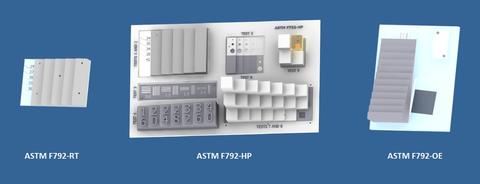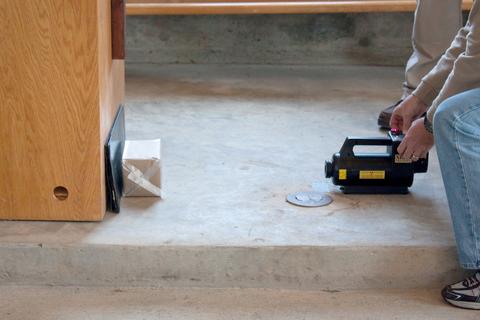X-ray Imaging of Concealed Threats and Contraband
X-ray imaging systems are used throughout the country by domestic and military law enforcement, corrections, and security agencies. These systems are used at international borders, in transportation venues, at government buildings, and other venues. The x-ray systems are used to find concealed objects, including threats and contraband. Every year, the United States government spends billions of dollars purchasing and using x-ray imaging technology for security and safety purposes.
Checkpoint X-ray Screening
The NIST Security Technologies Group (STG) led a recent effort to revise and update the foremost internationally-recognized and accepted imaging performance standard for checkpoint x-ray systems. This documentary standard, known as ASTM F792, “Standard Practice for Evaluating the Imaging Performance of Security X-ray Systems,” is widely used throughout the world to measure the image quality and materials detection capabilities of such systems (Ref. 1). The standard was developed in the 1980s and the STG-led 2017 revision was the first major revision for more than 15 years.
The revised standard now incorporates three distinct test objects for different testing scenarios, which greatly improves the applicability and usefulness of the standard that previously relied on a single test object. Each test object was developed by a subworking group that included representatives from industry and government agencies.
The three test objects, can be described as follows:
- The F792-RT is a small test object used for routine testing (RT) of an x-ray system (e.g. daily testing to ensure the system is functioning properly). This test object is a modification of the F792-88 test object that had been withdrawn but was still being used by industry for field verification of the imaging performance of the cabinet x-ray systems.
- The F792-HP test object relies on human perception (HP) judgements of feature visibility to score its tests. This is essentially an upgrade of the previous F792-08 test object with some major improvements, particularly to the materials detection tests.
- The F792-OE test object is designed to be objectively evaluated (OE), that is, evaluated using computer algorithms. The design of this test object differs from that of the RT and HP, which must be evaluated by humans. The images of the F792-OE test object are evaluated by a set of standard image analysis algorithms that are defined in the standard. As such, differences in human subjectivity or perception do not affect scoring on the OE tests.

Portable X-ray Imaging Systems
The NIST Security Technologies Group conducts research and develops standards related to portable x-ray systems used by bomb technicians. These systems are used by law enforcement and military bomb technicians throughout the world to take images of suspicious packages and explosive devices. The images are used to determine if these suspicious packages contain explosive devices and can also provide information about confirmed explosive devices to help choose appropriate render safe procedures.
The NIST Security Technologies Group led development of the ANSI N42.55, “American National Standard for the Performance of Portable Transmission X-Ray Systems for Use in Improvised Explosive Device and Hazardous Device Identification,” the internationally-accepted documentary performance standard for portable x-ray systems (Ref. 2). This was the first standard for these systems that provided a set of objectively evaluated image quality metrics, including: steel penetration, organic material detection, spatial resolution, dynamic range, and noise. This standard is cited by the National Bomb Squad Commanders Advisory Board (NBSCAB) in their annual “National Strategic Plan for U.S. Bomb Squads.” In addition to the objectively evaluated image quality metrics, the N42.55 contains the content of the National Institute of Justice NIJ Std 0603.01 (published in 2007), “Portable X-Ray Systems for Use in Bomb Identification,” thereby superseding the NIJ Std 0603.01.

The Security Technologies Group also conducts research into the relationship between image quality and task performance for portable x-ray systems. In other words, measurements of the task performance of expert bomb squad personnel, that is, their probability of detecting and identifying various threats in images, are made as a function of image quality. This research considers both conventional image quality metrics as well as natural scene statistics and permits investigation of which aspects of image quality are most important for task performance (Ref. 6).
Personnel X-ray Screening
The Security Technologies Group also conducts research and develops standards related to personnel x-ray screening systems, for both backscatter and transmission. Our interests extend from measuring image quality and its effect on task performance to radiation safety metrology, for example, ANSI/HPS N43.17 (Ref. 3) and its application (Ref. 4). We have also developed new materials discrimination techniques (Ref. 5).
ADDITIONAL TECHNICAL DETAILS
- ASTM Standard F792 2017, “Standard Practice for Evaluating the Imaging Performance of Security X-Ray Systems (link is external),” ASTM International, West Conshohocken, PA.
- IEEE/ANSI Standard N42.55-2013, “American National Standard for the Performance of Portable Transmission X-Ray Systems for Use in Improvised Explosive Device and Hazardous Device Identification (link is external).”
- ANSI/HPS Standard N43.17 2009, “Radiation Safety for Personnel Security Screening Systems Using X-Ray or Gamma Radiation (link is external).”
- “Assessment of the Rapiscan Secure 1000 Single Pose (ATR version) for Conformance with National Radiological Safety Standards”, J. L. Glover, R. Minniti, L. T. Hudson, and N. Paulter, NIST report for the TSA, inter-agency agreement HSHQDC-11-X-00585, 28 September 2012.
- “A method for organic/inorganic differentiation using an x-ray forward/backscatter personnel scanner (link is external)”, J. L. Glover and L. T. Hudson, X-ray Spectrometry Volume 42, Issue 6, pp 531-536, 2013.
- "Predicting detection performance on security X-ray images as a function of image quality", P Gupta, Z Sinno, JL Glover, NG Paulter, AC Bovik. IEEE Transactions on Image Processing 28 (7), 3328-3342 (2019).
MAJOR ACCOMPLISHMENTS
- 2017: ASTM F792 approved (Ref 1.)
- 2013: IEEE/ANSI N42.55 published (Ref 2.)
- 2012: Radiation safety assessment of Rapiscan Secure 1000 completed (Ref 4.)
LINKS
- UT – Austin’s Laboratory for Image and Video Engineering: https://www.ece.utexas.edu/research/groups/laboratory-image-and-video-engineering-live
- Committee ANSI N43: https://hps.org/hpssc/n43standards/
- FBI’s Hazardous Devices School: https://www.fbiagentedu.org/careers/tactical-operations/hazardous-devices-school/
- International Association of Bomb Technicians and Investigators: https://www.iabti.org/
- DHS’ Response and Defeat Operations Support (REDPOS): https://www.dhs.gov/science-and-technology/redops-100-seconds
- ASTM committee F12.60: https://www.astm.org/membership-participation/technical-committees/committee-f12/subcommittee-f12/jurisdiction-f1260
- NIJ Std 0603.01: https://nij.ojp.gov/topics/equipment-and-technology/active-nij-standards-and-comparative-test-methods (link is external)
CUSTOMERS/CONTRIBUTORS/COLLABORATORS
- Lawrence Hudson, NIST
- National Bomb Squad Commanders Advisory Board
- Alan Bovik (link is external), UT – Austin
Contacts
-
(301) 975-8821

